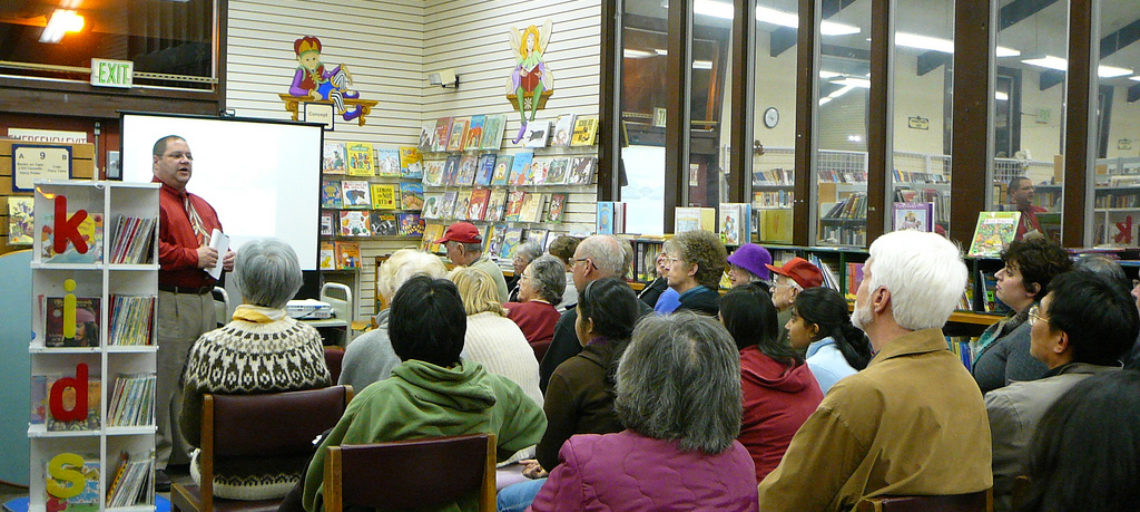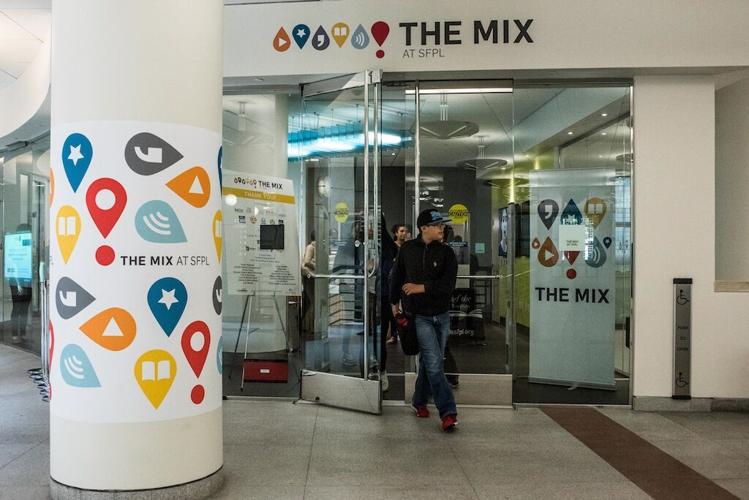
Picture of a public library engaging with the community (Monk, 2017)
Libraries of the 21st century have evolved to be more than large storehouses of books with cranky librarians sitting at desks telling patrons to quiet down. They have transformed into community hubs that promote lifelong learning, enhance community engagement, support social infrastructure, and serve as a third place by providing services, programs, and collections that meet the needs of the communities they serve. Although many libraries have made significant strides in providing essential services, a considerable number of people remain ignorant of the value that libraries can bring to the community. There were many concepts, models, and themes discussed in the foundational modules that all library professionals should be aware of in order to take their library to Library 2.0, but this blog will focus on one key concept: participatory service. From the various lectures, readings, and videos, this author found that the concept of participatory service encompasses two separate, but interrelated, aspects of library work: community involvement and maker culture. By embracing participatory service, libraries can provide services that various communities are looking for, thus increasing library usage and community support (Casey & Savastinuk, 2007; Stephens, 2016, 2019, 2025).
Participatory Service and Community Involvement
(Mikwaukee Public Library, 2024)
While getting community feedback is something that many libraries have already been doing, participatory service transforms community feedback into community involvement. In an era of Web 2.0, smartphones, and emerging technologies, libraries have a limited amount of time to capture a patron’s attention to encourage them to interact with the library. When creating or analyzing library services, library professionals can no longer rely solely on the notion that “well, this is how it has always been done.” Community involvement allows users and non-users of the library to not only give feedback on every aspect of the library, including collection development, programs, services, and the physical and digital space(s), but also involves them in the entire project lifecycle from the planning phases all the way through the evaluation stages (Casey & Savastinuk, 2007; Stephens, 2016, 2019). It is essential to note that although library professionals should evaluate the project after it has been implemented, evaluation should occur throughout the project’s lifecycle. Correcting the course later in the project’s stages is much more expensive and time-consuming than it is in the earlier stages. This concept may be intimidating to some, but reluctant library professionals must remember that human beings are the sun around which the library revolves (Kenney, 2014; Schneider, 2006).
Without our patrons, libraries would not exist; therefore, library professionals must open as many channels of communication as possible to meet our patrons where they are and to show that the library is transparent. Because many of our users are taking advantage of Web 2.0 technologies and utilizing social media to create and consume content, libraries should also be there, on multiple platforms. Libraries having accounts on social media is not a new concept, but library professionals running the accounts should do much more than just post announcements on what the library is currently doing. The posts should be regularly scheduled, creative, match the platform’s format, and also invite communication from the community. A notable example is the Milwaukee Public Library’s (MPL) Instagram account, which boasts 228,000 followers, with some posts garnering nearly one million likes (Milwaukee Public Library, n.d). On a personal note, this author was a little disheartened researching all the wonderful outreach opportunities that social media provides, as the stakeholder that his library is beholden to does not allow individual departments to run their own social media account. A library interested in in-person communication should consider holding meetings with political leaders, community leaders, staff, and patrons to understand what these multiple stakeholders truly want from the library. Furthermore, the library should also consider establishing advisory boards, such as a Teen Advisory Board (TAB), comprising diverse community members, to provide a reliable source of information when considering the creation of new programs or services.
Participatory Service and Maker Culture

Picture of the entrance to The Mix at the San Francisco Public Library (Koozmin, 2015)
When brainstorming programs for any age group, library professionals should move beyond creating ones that involve participants following a set of rules to produce a singular product that resembles everyone else’s. These modules introduced the term radical trust to this author for the first time, and he absolutely loves this idea. While the term is more applicable to participatory service and community involvement, as radical trust involves trusting community feedback to guide the library into the future, this term can also be applied to actual programming. Mattern (2014) envisions libraries as open platforms where people can utilize the tools and physical spaces provided to develop software, knowledge, and community, allowing them to do more than just consume media or follow specific instructions (Casey & Savastinuk, 2007; Stephens, 2006, 2016, 2019). The Dokk1 library has done and continues to do an excellent job of embracing radical trust and maker culture by implementing a digital storytelling tool called Multi Touch, which allows patrons to bring in their own content to share, including photos, stories, recipes, and opinions (Boekesteijn, 2011). This library also sets a great example of how to incorporate technology in a meaningful way that contributes to community building, rather than for the sake of having the newest technology. The San Francisco Public Library (SFPL) is another library that excels at embracing radical trust and maker culture through The Mix, a teen space where young adults can engage in various activities, including playing board games, recording music, hosting group activities, playing video games, studying, and utilizing the maker space room (O’Brien, 2019). Not only does this excellent space at the SFPL provide teens with the opportunity to be creative, but it also helps them become familiar and comfortable with the library’s resources as they transition into adulthood. Furthermore, O’Brien (2019) emphasizes that the SFPL maintained constant communication with the community regarding the creation of The Mix, ensuring that this initiative was something the community wanted.
References
Boekesteijn, E. (2011, February 15). DOK Delft takes user generated content to the next level. Tame the Web. https://tametheweb.com/2011/02/15/dok-delft-takes-user-generated-content-to-the-next-level-a-ttw-guest-post-by-erik-boekesteijn/
Casey, M. E., & Savastinuk, L. C. (2007). Library 2.0: A guide to participatory library service (1st ed.). Information Today.
Kenney, B. (2014, January 27). The user is (still) not broken. Publishers Weekly. https://www.publishersweekly.com/pw/by-topic/industry-news/libraries/article/60780-the-user-is-still-not-broken.html
Koozmin, M. (2015). Mayor celebrates opening of The Mix teen center at SF public library. San Francisco Examiner. https://www.sfexaminer.com/multimedia/photo-galleries/mayor-celebrates-opening-of-the-mix-teen-center-at-sf-public-library/article_f67da5d9-bdf6-596e-9484-cce3e31a8550.html
Mattern, S. (2014, June). Library as infrastructure. Places. https://placesjournal.org/article/library-as-infrastructure/?cn-reloaded=1
Milwaukee Public Library [@milwaukeepubliclibrary]. (n.d.). Posts [Instagram page]. Instagram. Retrieved June 22, 2025, from https://www.instagram.com/milwaukeepubliclibrary/
Milwaukee Public Library [@MilwaukeePublicLibraryHome]. (2024, March 18). Sassy manga grandma [YouTube short]. YouTube. https://www.youtube.com/shorts/Lyp-ZMBsWRI
Monk, J. (2017, June 7). Public libraries in the 21st century: A new home for community engagement. Samuel Centre for Social Connectedness. https://www.socialconnectedness.org/public-libraries-in-the-21st-century-a-new-home-for-community-engagement/
O’Brien, C. (2019, June 24). How San Francisco’s public libraries are embracing their changing role. Shareable. https://www.shareable.net/how-san-francisco-public-libraries-are-embracing-their-changing-role/
Schneider, K. G. (2006, June 3). The user is not broken: A meme masquerading as a manifesto. Free Range Librarian. https://freerangelibrarian.com/2006/06/03/the-user-is-not-broken-a-meme-masquerading-as-a-manifesto/
Stephens, M. T. (2016). The heart of librarianship: Attentive, positive, and purposeful change (1st ed.). ALA Editions.
Stephens, M. T. (2019). Wholehearted librarianship: Finding hope, inspiration, and balance (1st ed.). ALA Editions.
Stephens, M. T. (2025). The hyperlinked library: Participatory service and transparency [Recorded lecture]. Panopto. https://sjsu-ischool.hosted.panopto.com/Panopto/Pages/Viewer.aspx?id=2a19a4b6-e945-4d2e-abf1-aef3014172a5